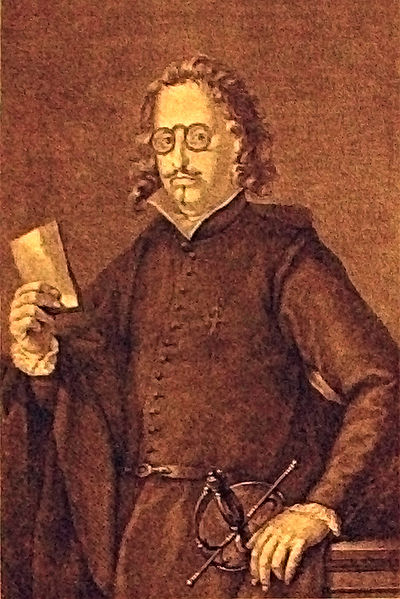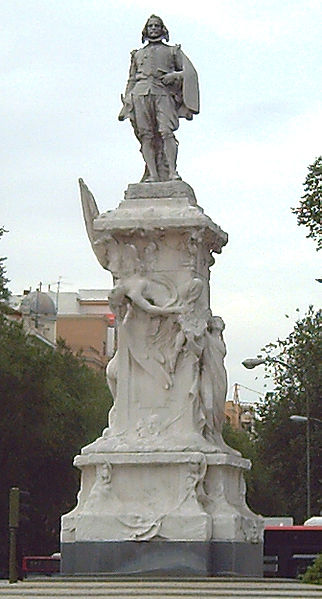<Back to Index>
- Naturalist Friedrich Wilhelm Heinrich Alexander von Humboldt, 1769
- Writer Francisco Gómez de Quevedo y Santibáñez Villegas, 1580
- President of the Republic of Guatemala Jacobo Árbenz Guzmán, 1913


Francisco Gómez de Quevedo y Santibáñez Villegas (Madrid, 14 September 1580 – Villanueva de los Infantes, 8 September 1645) was a nobleman, politician and writer of the Baroque Era. Along with his lifelong rival, Luis de Góngora, Quevedo was one of the most prominent Spanish poets of the age. His style is characterized by what was called conceptismo. This style existed in stark contrast to Góngora’s culteranismo.
Quevedo was born to a family of hidalgos from the village of Vejorís, located in the northern mountainous region of Cantabria. His family was descended from the Castilian nobility. Quevedo's father, Francisco Gómez de Quevedo, was secretary to Maria of Spain, daughter of emperor Charles V and wife of Maximilian II, Holy Roman Emperor, and his mother, Madrid-born María de Santibáñez, was lady-in-waiting to
the queen. Quevedo matured surrounded by dignitaries and nobility at
the royal court. Intellectually gifted, Quevedo was physically
handicapped with a club foot, obesity, and myopia. Since he always wore pince-nez, his name in the plural, quevedos, came to mean "pince-nez" in the Spanish language. Orphaned by the age of six, he was able to attend the Imperial School run by the Jesuits in Madrid. He then attended university at Alcalá de Henares from 1596 to 1600. By his own account, he made independent studies in philosophy, classical languages, Arabic, Hebrew, French and Italian. In 1601, Quevedo, as a member of the Court, moved to Valladolid, where the Court had been transferred by the King's minister, the Duke of Lerma. There he studied theology, a subject that would become a lifelong interest, and on which in later life he would compose the treatise Providencia de Dios (God’s Providence), against atheism. By
this time, he was becoming noted as both a poet and a prose writer.
Some of his poetry was collected in a 1605 generational anthology by
Pedro Espinosa entitled Flores de Poetas Ilustres (Flowers by Illustrious Poets). We can also date back to this time the first draft of his picaresque novel Vida del Buscón - apparently
written as an exercise in courtly wit - and a few satirical pamphlets
that made him famous among his fellow students and which he would later
disown as juvenile pranks. Around this time, he began a very erudite exchange of letters with the humanist Justus Lipsius,
in which Quevedo deplored the wars that were ravaging Europe. The Court
returned to Madrid in 1606, and Quevedo followed, remaining till 1611.
By then, he was a well-known and accomplished man-of-letters. He
befriended and was praised by Miguel de Cervantes and Lope de Vega, the premier playwright of the age. But he also made enemies, among others, of the dramatist Juan Ruiz de Alarcón for, despite his own physical handicaps, Quevedo found Alarcón's redheaded and hunchbacked physique a source of amusement. Quevedo also attacked Juan Pérez de Montalbán, the son of a bookseller with whom he had quarrelled, satirizing him in “La Perinola” ("The Whirligig"), a cruel piece that he included in his book Para Todos (To Everyone). In 1608, Quevedo dueled with the author and fencing master Luis Pacheco de Narváez as
a result of Quevedo criticizing one of Narváez's works. Quevedo
took off Pacheco's hat in the first encounter. They remained enemies
all their lives. In Quevedo's Buscón,
this duel was parodied with a fencer relying on mathematical
calculations having to run away from a duel with an experienced soldier. Quevedo could be impulsive. He was present at the church of San Martín in
Madrid when a woman praying there was slapped on the cheek by another
man who had rushed up to her. Quevedo seized the man, dragging him
outside the church. The two men drew swords, and Quevedo ran his
opponent through. The man, who died of his wounds some time later, was
someone of importance. Quevedo thus retired temporarily to the palace
of his friend and patron, Pedro Téllez-Girón, 3rd Duke of Osuna. The
preferred object of his fury and ridicule, however, was the poet
Góngora, whom, in a series of scathing satires, he accused of
being an unworthy priest, a homosexual, a gambler, and a writer of indecent verse who used a purposefully obscure language. Quevedo lampooned his rival by writing a sonnet, “Aguja de navegar cultos,” which listed words from Góngora’s lexicon: “He would like to be a culto poet in just one day, / must the following jargon learn: / Fulgores, arrogar, joven, presiente / candor, construye, métrica, armonía...” With
the bluntness of his age, Quevedo mercilessly satirized even
Góngora's physique, particularly his prominent nose (most
famously in the sonnet "A una nariz," ["To a Nose"]), which in his day
was thought to imply a Jewish heritage, with all the shame, possible censorship, and persecution that such a connection implied in the Spain of the time. Quevedo's "A una nariz" begins with the lines: Érase
un hombre a una nariz pegado, / érase una nariz superlativa, /
érase una nariz sayón y escriba, / érase un peje
espada muy barbado. Góngora reciprocated with almost equal virulence.
About that time, Quevedo grew very close to Pedro Téllez-Girón, 3rd Duke of Osuna, one of the great statesmen and generals of the age, whom he accompanied as secretary to Italy in 1613, carrying out a number of missions for him which took him to Nice, Venice and finally back to Madrid. There he engaged in all manner of courtly intrigue to get the viceroyalty of
Naples for Osuna, an effort that finally bore fruit in 1616. He then
returned to Italy in the Duke's entourage, where he was entrusted with
putting in order the Viceroyalty's finances, and sent on several espionage-related missions to the rival Republic of Venice, although it is now believed these did not involve him personally. He was rewarded for his efforts with a knighthood in the order of Santiago in 1618. With the fall from favor of Osuna in 1620, Quevedo lost his patron and protector and was exiled to Torre de Juan Abad (Ciudad Real),
whose fiefdom his mother had purchased for him. His supposed vassals,
however, refused to acknowledge him, forcing Quevedo into an
interminable legal battle with the town's council that would not be won until after his death. Quevedo
would write some of his better poetry in this retirement, such as the
sonnet "Retirado a la paz de estos desiertos..." or "Son las torres de
Joray...". He found consolation to his failed ambitions as a courtier
in the Stoicism of Seneca, his study and commentary turning him into one of the main exponents of Spanish Neostoicism. The elevation of Philip IV to
the throne in 1621 meant the end of Quevedo's exile, and his return to
Court and politics, now under the influence of the new minister, the Count-Duke of Olivares. Quevedo accompanied the young king in trips to Andalusia and Aragon, recounting some of its various incidents in interesting letters. At this time he decided to denounce to the Spanish Inquisition his own works, published without his consent by profiteering booksellers.
It was a move to frighten off the booksellers and regain control over
his writings, with a view to a definitive edition of his work that was
not to come in his lifetime. He became known for a disorderly lifestyle: he was a heavy smoker, a frequent visitor to brothels and taverns, and cohabited with a woman only known as "Ledesma." Góngora derided him as a drunkard in a satirical poem as Don Francisco de Quebebo (a play on his name that can be roughly translated as "Don Francisco of What-I-drink.") None
of this put a stop to his career at court, perhaps because the king had
an equally rowdy reputation. In fact, in 1632 he would become secretary
to the king, thus reaching the apex of his political career. His friend Antonio Juan de la Cerda, the Duke de Medinaceli,
forced Quevedo to marry against his will with Doña Esperanza de
Aragón, a widow with children. The marriage, made in 1634,
barely lasted three months. Quevedo filled these years with febrile
creative activity. In 1634 he published La cuna y la sepultura (The cradle and the sepulchre) and the translation of La introducción a la vida devota (The introduction to a life of devotion) of Francis of Sales; between 1633-1635 he completed works like De los remedios de cualquier fortuna (Of the remedies of any fortune), the Epicteto, Virtud Militante, Los cuatro fantasmas (The four ghosts), the second part of Política de Dios (Politics of God), Visita y anatomía de la cabeza del cardenal Richelieu (Visit and anatomy of the head of the Cardinal Richelieu) or Carta a Luis XIII (Letter to Louis XIII). In 1635 there appeared in Valencia the most important of the numerous libels destined to defame him, El
tribunal de la justa venganza, erigido contra los escritos de Francisco
de Quevedo, maestro de errores, doctor en desvergüenzas,
licenciado en bufonerías, bachiller en suciedades,
catedrático de vicios y protodiablo entre los hombres. (The
Court of the rightful revenge, erected against the writings of
Francisco de Quevedo, teacher of errors, doctor in shamelessness,
licensed in buffonery, bachelor in dirt, university professor of vices
and proto-devil among men). In
1639, he was arrested. His books were confiscated. The authorities,
hardly giving Quevedo time to get dressed, took the poet to the convent of San Marcos in León. In the monastery Quevedo dedicated himself to reading, as recounted in his Carta moral e instructiva (Moral and instructive letter),
written to his friend, Adán de la Parra, depicting hour by hour
his prison life ("From ten to eleven, I spend my time in prayer and
devotions, and from eleven to noon I read good and bad authors; because
there is no book, despicable as it can be, that does not contain
something good..."). Quevedo,
who was frail and very ill when he left from his confinement in 1643,
resigned from royal court definitively to retire at Torre de Juan Abad.
He died in the Dominican convent
of Villanueva de los Infantes, on 8 September, 1645. One tale tells
that his tomb was pillaged days later by a gentleman who wished to have
the gold spurs with which Quevedo had been buried. Quevedo was an adherent of the style known as conceptismo, a name derived from concepto, which has been defined as "a brilliant flash of wit expressed in pithy or epigrammatic style." Conceptismo is
characterized by a rapid rhythm, directness, simple vocabulary, witty
metaphors, and wordplay. In this style, multiple meanings are conveyed
in a very concise manner, and conceptual intricacies are emphasised
over elaborate vocabulary. Conceptismo can effect elegant philosophical depth, as well as biting satire and humor, such as in the case of the works of Quevedo and Baltasar Gracián. The first tercet from Quevedo's sonnet "¡Ah de la vida!" is considered to exemplify conceptismo in poetry at its peak: